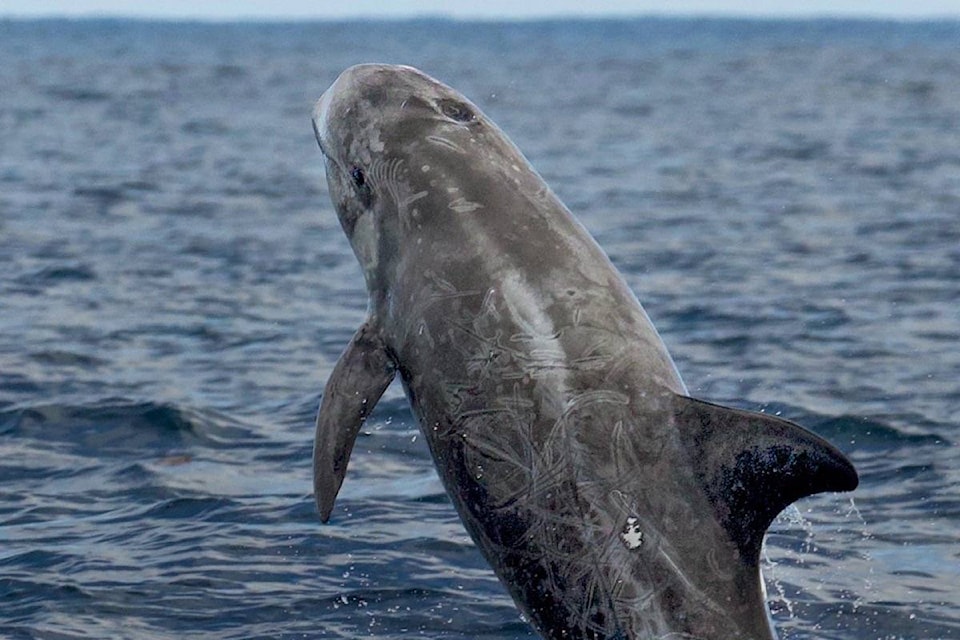With a $20,000 Clayoquot Biosphere Trust Research Award in tow, the Strawberry Isle Marine Research Society (SIMRS) can dive into revitalizing a Pelagic Marine Species Survey founder Rod Palm first implemented in 1993.
Once a month for a year, a small team of four to six observers will travel about 35 nautical miles off the shores of Tofino through the Clayoquot Canyon, and past the continental shelf break to the Abyssal plain to record marine mammal and bird species for an open-access database available to researchers, policymakers, organizations, and the local community.
SIMRS executive director Karyssa Arnett says the Pelagic Marine Species Survey that Palm conducted in the early 90s provides a historical baseline on which their team will attempt to systematically replicate in order to assess changes and address conservation concerns.
“This is a pretty timely project in the fact that it is the United Nations Decade of Ocean Science. It’s now becoming really clear to a lot of people that we need to be observing our oceans and conducting research on our oceans in order to be able to deal with global issues like climate change,” said Arnett.
To reach the Pelagic transect location takes over 6 hours round trip travelling at a steady pace of 20 knots/hour. (google maps)
Taking a boat offshore for a day is costly, notes Arnett, plus the weather window is slim.
“Receiving the (CBT) Research Grant is amazing for our own biosphere region because we will be able to be in the forefront of that ocean science and be able to provide data that supports just how much we depend on our ocean and the species are within and how much the ocean sustains our local communities as well. It’s going to be an amazing research project to be doing here locally,” she said.
The SIMRS team is partnering with research advisors Dr. Rianna Burnham and Dr. Dave Duffus of the University of Victoria Whale Research Lab for the pelagic survey. The Ahousaht First Nation’s Maaqutusiis Hahoulthee Stewardship Society is supporting the project and assigning a stewardship biologist to help collect data as the research occurs in their traditional waterways. Mark Maftei, executive director of the Raincoast Education Society, will be the resident bird expert on deck.
“Back in the day we had Adrian Dorst who was working with Rod Palm,” Arnett said. “We are all working together to get this data collected and to share with as many research project going on as possible.”
Dr. Rianna Burnham says she is really excited to help re-establish the pelagic survey. The revitalized work will incorporate new technology like recording acoustics with hydrophones and deploying drones to maximize their data collection.
“Rod (Palm) set a real baseline way before we realized we needed to look into this. Now we are setting another reference point and as we go forward, we can see the changes that occurred in a 30-year period, and we can oceans are warming, conditions are changing and the whole system is starting to look a little bit different,” said Burnham, who currently studies killer whales in acoustic environment for Fisheries and Oceans Canada.
CBT research director Dr. Laura Loucks says she’s curious to see the similarities and differences between the bird species identified in Rod Palm’s research from the 1990s compared with today.
“For example, the original data set documented a consistent presence of Marbled Murrelets in the winter months. Marbled Murrelets are a Blue listed bird species in BC and classified as Threatened by COSEWIC (Committee on the Status of Endangered Species in Canada). They are also a significant indicator species, given that they nest in old growth coastal rainforests and their habitat loss has been a real concern in B.C. Additional concerns are related to the increased threat from shipping traffic, fisheries by-catch and warming sea temperatures due to the warming global climate,” wrote Dr. Loucks in an email to the Westerly.
This is the seventh annual Biosphere Research Award the CBT has issued since the inception of this grant in 2015. Past recipients include: Thornton Creek Enhancement Society (West coast juvenile chinook survival project), Raincoast Education Society (Migrating shorebirds study), Central Westcoast Forest Society ((Tranquil Estuary Chinook restoration), University of Victoria/Hesquiaht Language Program (Nuu-chah-nulth (NCN) worldview and place-based language revitalization), Association of Wetland Stewards for Clayoquot and Barkley Sounds (Conservation of Amphibian Migration Across Roads), and Pacific Wildlife Foundation (Gray Whale study).
Successful applicants must conduct research that addresses: (1) key ecosystem threats; and (2) conservation action within the Clayoquot Sound UNESCO Biosphere Region. To learn more about about the Clayoquot Biosphere Trust’s granting stream, visit Clayoquot Biosphere Grants.
Grade 9 student Chloe Platenius interviews Karyssa Arnett from Strawberry Isle Marine Research Society, to learn about their Sea Star Stewardship Program.
RELATED: Washed up Risso’s dolphin offers glimpse into “whole other world” near Tofino
nora.omalley@westerlynews.ca
Like us on Facebook and follow us on Twitter
READ: B.C. children’s writer encourages girls to pursue the sciences in new book
READ: Non-profit buys Chinook ranch in hopes of increasing feed for southern resident killer whales
